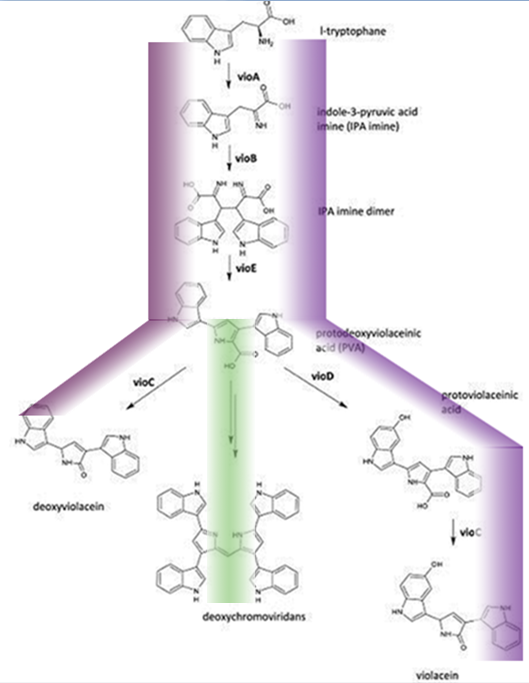|
|
Biosynthesis - Violacein
Background
Violacein is a pigment produced by several bacteria, initially discovered in Chromobacterium violaceum, through pathway of 5 related genes, vioA, vioB, vioC, vioD and vioE. This intermediate of tryptophan has such special applications as antibacterial, anti-trypanocidal, anti-ulcerogenic, and anticancer drugs(Hoshino). Besides, Vio-Operon parts are available in the Registry and have been proved functional by the Cambridge 2009 iGEM team.
Violacein Biosynthetic Pathway
 Fig.1 :The violacein biosynthetic pathway. The purple line indicates the biosynthetic flux of pigment deoxyviolacein and violet. The green line indicates the the biosynthetic flux of pigment deoxychromoviridans. One key prerequisite in the metabolic flux is that: Automatically VioA, VioB and VioE can assemble and function, turning L-tryptophen into an intermediate, PVA(protodeoxyviolaceic acid). Before action of VioD or VioC, one intrinsic E.coli enzyme aids in an additional side reaction, further modifying PVA into a green pigment called deoxychromoviridans. Moreover, VioC alone transfers PVA into a purple pigment, deoxyviolacein. VioC, VioD together, however, produce violacein, the violet pigment most well-studied among these three, introducing alternative reaction.
Former study has shown that by means of separation, such as thin-layer chromatography (TLC), or high-performance liquid chromatography (HPLC), different pigment metabolites in this biosynthetic pathway could be identified. Thus two interesting branches of the pathway could be utilized in service of verification of our membrane system.
Design of Membrane Complex
We chose violacein mainly because of the branching feature of its pathway, which could be one good choice for verification of our membrane switch.
- To evaluate the efficiency of our system, we linked vio genes and the key scaffold together, inserted the whole complex into reconstructed vectors and expressed them in E.coli . As stated in the [System Construction] section, SsDsbA part is a signal sequence to locate complex to membrane, lgt is a membrane protein which function as a harbor for other proteins, all the other parts with a "L" or a "D" stand for dimer proteins' ligand part or domain part which work like magnets that pull the complex together.
//膜蛋白图片
- Here, we replaced EGFP with one vio gene. Complex 1(carrying vioA) and complex 3(carrying vioC) were inserted into site 1 and site 2 of pETduet-1 accordingly. Complex 2(carrying vioB) and complex 4(carrying vioE) were inserted into site 1 and site 2 of pRSFduet-1 respectively. Then both plasmids were transferred into BL21, and the vio genes were expressed.
- We constructed a control group also, and inserted only rbs-vio gene into the corresponding site of plasmids.If everything works as estimation, we could observe considerate augmentation of deoxyviolacein yields due to the shortened distance between key enzymes. The final results can be directly achieved by HPLC.
2. Membrane Switch
- The switch of violacein biosynthesis could only be realized with all 5 vio genes together. And since vioB and vioE normally function in dimer state, thus we replace membrane complex2(carrying vioB)with rbs-vioB-vioE-pRSF plasmid for compensation.
- In addition to the former four complexes, we also constructed the 5th one for vioD. In order to control the direction of reaction flow, we added an outer-membrane light-inducing-dimerizable protein VIVID between SsDsbA and lgt for vioC and vioD, shown as [figure3].
//figure3上图
- VVD was first discovered in Neurospora crassa, dimerizes upon transient induction by light and its mutants has been found to display enhanced carotenoid pigmentation in response to light signal.(Shrode, Lewis et al. 2001)
- As long as VVD is photo-induced, according to our assumption, violacein should be dominant although all three pigments are present.
Results and Discussion
Plasmids as designed has been successfully constructed and transformed into E. coli. Single clones are picked and cultured in LB(Amp+,Kan+,Cl+) overnight, then we added arabinose for induction(supplemented with 1 mM δ-aminolevulinic acid and 40 uM ammonium iron sulfate for VioB). To ensure the efficiency of membrane switch, the bacteria culture was under bluelight during induction period.
After 5h, there appeared to be visible sigments particles in the liquid. We lysated the bateria using isasteric 10% SDS followed by 20min' ultrasonication. The pigments were extrated by ethylacetate, rotovaped for 20min and then resuspended using methanol(HPLC level). Then the samples were analyzed with HPLC(Agilent Series 2000 C18 column).
MERDE= =HPLC图片还有一排小瓶子的图片
Reference
1. Balibar, C. J. and C. T. Walsh (2006). "In vitro biosynthesis of violacein from L-tryptophan by the enzymes VioA-E from Chromobacterium violaceum." Biochemistry 45(51): 15444-57.
2. Hoshino, T. "Violacein and related tryptophan metabolites produced by Chromobacterium violaceum: biosynthetic mechanism and pathway for construction of violacein core." Appl Microbiol Biotechnol 91(6): 1463-75.
3. Shrode, L. B., Z. A. Lewis, et al. (2001). "vvd is required for light adaptation of conidiation-specific genes of Neurospora crassa, but not circadian conidiation." Fungal Genet Biol 32(3): 169-81.
|